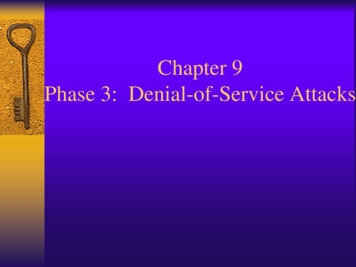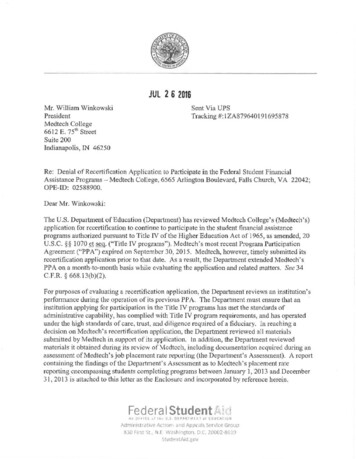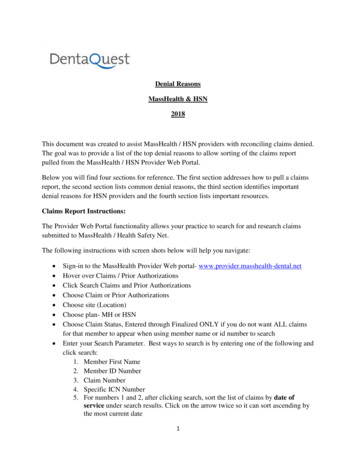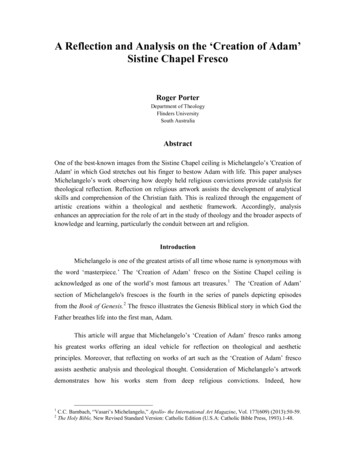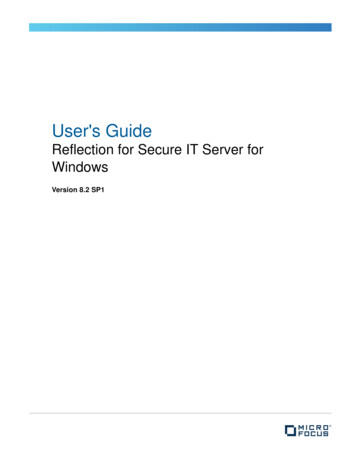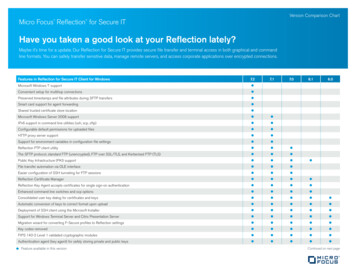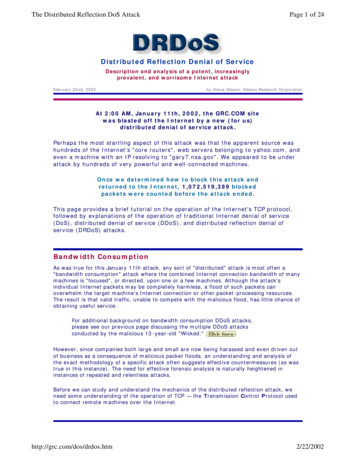
Transcription
The Distributed Reflection DoS AttackPage 1 of 24Distributed Reflection Denial of ServiceDescription and analysis of a potent, increasinglyprevalent, and worrisome Internet attackFebruary 22nd, 2002by Steve Gibson, Gibson Research CorporationAt 2:00 AM, January 11th, 2002, the GRC.COM sitewas blasted off the Internet by a new (for us)distributed denial of service attack.Perhaps the most startling aspect of this attack was that the apparent source washundreds of the Internet's "core routers", web servers belonging to yahoo.com, andeven a machine with an IP resolving to "gary7.nsa.gov". We appeared to be underattack by hundreds of very powerful and well-connected machines.Once we determined how to block this attack andreturned to the Internet, 1,072,519,399 blockedpackets were counted before the attack ended.This page provides a brief tutorial on the operation of the Internet's TCP protocol,followed by explanations of the operation of traditional Internet denial of service(DoS), distributed denial of service (DDoS), and distributed reflection denial ofservice (DRDoS) attacks.Bandwidth ConsumptionAs was true for this January 11th attack, any sort of "distributed" attack is most often a"bandwidth consumption" attack where the combined Internet connection bandwidth of manymachines is "focused", or directed, upon one or a few machines. Although the attack'sindividual Internet packets may be completely harmless, a flood of such packets canoverwhelm the target machine's Internet connection or other packet-processing resources.The result is that valid traffic, unable to compete with the malicious flood, has little chance ofobtaining useful service.For additional background on bandwidth consumption DDoS attacks,please see our previous page discussing the multiple DDoS attacksconducted by the malicious 13 -year-old "Wicked."However, since companies both large and small are now being harassed and even driven outof business as a consequence of malicious packet floods, an understanding and analysis ofthe exact methodology of a specific attack often suggests effective countermeasures (as wastrue in this instance). The need for effective forensic analysis is naturally heightened ininstances of repeated and relentless attacks.Before we can study and understand the mechanics of the distributed reflection attack, weneed some understanding of the operation of TCP — the Transmission Control Protocol usedto connect remote machines over the Internet.http://grc.com/dos/drdos.htm2/22/2002
The Distributed Reflection DoS AttackPage 2 of 24TCP Connections 101:I can recall many years ago, well before the Internet "happened", hearing talk of twomachines "connecting" to each other over the Internet. As a software-savvy hardwareengineer, I remember thinking, "Connecting? How can two machines be 'connected' to eachother over a global network?" I later learned that two machines, able to address and sendpackets of data to each other, negotiated a "connection agreement." The result of theirsuccessful negotiation is a "Virtual TCP Connection."Individual TCP packets contain "flag bits" which specify the contents and purpose of eachpacket. For example, a packet with the "SYN" (synchronize) flag bit set is initiating aconnection from the sender to the recipient. A packet with the "ACK" (acknowledge) flag bitset is acknowledging the receipt of information from the sender. A packet with the"FIN" (finish) bit set is terminating the connection from the sender to the recipient.The establishment of a TCP connection typically requires the exchange of three Internetpackets between two machines in an interchange known as the TCP Three-WayHandshake. Here's how it works:SYN: A TCP client (such as a web browser, ftp client, etc.) initiates aconnection with a TCP server by sending a "SYN" packet to the server.As shown in the diagram above, this SYN packet is usually sent from the client's port,numbered between 1024 and 65535, to the server's port, numbered between 1 and 1023.Client programs running on the client machine ask the operating system to "assign them aport" for use in connecting to a remote server. This upper range of ports is known as the"client" or "ephemeral" port range. Similarly, server programs running on the server machineask the operating system for the privilege of "listening" for incoming traffic on specific portnumbers. This lower port range is known as "service ports." For example, a web serverprogram typically listens for incoming packets on port 80 of its machine, and web browsingclients generally send their web packets to port 80 of remote servers.Note that in addition to source and destination port numbers, each packet also contains theIP address of the machine which originated the packet (the Source IP) and the address of themachine to which the Internet's routers will forward the packet (the Destination IP).SYN/ACK: When a connection-requesting SYN packet is received at an "open"TCP service port, the server's operating system replies with a connectionaccepting "SYN/ACK" packet.Although TCP connections are bi -directional (full duplex), each direction of the connection isset up and managed independently. For this reason, a TCP server replies to the client'sconnection-requesting SYN packet by ACKnowledging the client's packet and sending its ownSYN to initiate a connection in the returning direction. These two messages are combinedinto a single "SYN/ACK" response packet.http://grc.com/dos/drdos.htm2/22/2002
The Distributed Reflection DoS AttackPage 3 of 24The SYN/ACK packet is sent to the SYN's sender by exchanging the source and destinationIPs from the SYN packet and placing them into the answering SYN/ACK packet. This sets theSYN/ACK packet's destination to the source IP of the SYN, which is exactly what we want.Note that whereas the client's packet was sent to the server's service port — 80 in theexample shown above — the server's replying packet is returned from the same service port.In other words, just as the source and destination IPs are exchanged in the returning packet,so are the source and destination ports.The client's reception of the server's SYN/ACK packet confirms the server's willingness toaccept the client's connection. It also confirms, for the client, that a round-trip path existsbetween the client and server. If the server had been unable or unwilling to accept theclient's TCP connection, it would have replied with a RST/ACK (Reset Acknowledgement)packet, or an ICMP Port Unreachable packet, to inform the client that its connection requesthad been denied.ACK: When the client receives the server's acknowledging SYN/ACK packet forthe pending connection, it replies with an ACK packet.The client ACKnowledges the receipt of the SYN portion of the server's answeringSYN/ACK by sending an ACK packet back to the server. At this point, from the client'sperspective, a new two-way TCP connection has been established between the client andserver, and data may now freely flow in either direction between the two TCP endpoints.The server's reception of the client's ACK packet confirms to the server that its SYN/ACKpacket was able to return to the client across the Internet's packet routing system. At thispoint, the server considers that a new two-way TCP connection has been established betweenthe client and server and data may now flow freely in either direction between the two TCPendpoints.For More Information: The pages describing the design and operationof my custom DoS-proof TCP/IP protocol stack goes into much greaterdetail which is not relevant to this page's discussion.Abusing TCP: The Traditional SYN FloodSeveral years ago, a weakness in the TCP connection handling of many operating systemswas discovered and exploited by malicious Internet hackers.As shown in the TCP transaction diagram above, the server's receipt of a client's SYN packetcauses the server to prepare for a connection. It typically allocates memory buffers forsending and receiving the connection's data, and it records the various details of the client'sconnection including the client's remote IP and connection port number. In this way, theserver will be prepared to accept the client's final connection-opening ACK packet. Also, if theclient's ACK packet should fail to arrive, the server will be able to resend its SYN/ACK packet,presuming that it might have been lost or dropped by an intermediate Internet router.But think about that for a minute. This means that memory and other significant server"connection resources" are allocated as a consequence of the receipt of a single Internet"SYN" packet. Clever but malicious Internet hackers figured that there had to be a limit to thenumber of "half open" connections a TCP server could handle, and they came up with asimple means for exceeding those limits:http://grc.com/dos/drdos.htm2/22/2002
The Distributed Reflection DoS AttackPage 4 of 24Through the use of "Raw Sockets", the packet's "return address" (source IP) can beoverridden and falsified. When a SYN packet with a spoofed source IP arrives at the server, itappears as any other valid connection request. The server will allocate the required memorybuffers, record the information about the new connection, and send an answering SYN/ACKpacket back to the client.But since the source IP contained in the SYN packet was deliberately falsified (it is often arandom number), the SYN/ACK will be sent to a random IP address on the Internet. If thepacket were addressed to a valid IP, the machine at that address might reply with a"RST" (reset) packet to let the server know that it did not request a connection. But with over4 billion Internet addresses, the chances are that there will be no machine at the address andthe packet will be discarded.The problem is, the server has no way of knowing that the malicious client's connectionrequest was fraudulent, so it needs to treat it like any other valid pending connection. Itneeds to wait for some time for the client to complete the three-way handshake. If the ACK isnot received, the server needs to resend the SYN/ACK in the belief that it might have beenlost on its way back to the client.As you can imagine, all of this connection management consumes valuable and limitedresources in the server. Meanwhile, the attacking TCP client continues firing additionalfraudulent SYN packets at the server, forcing it to accumulate a continuously growing pool ofincomplete connections. At some point, the server will be unable to accommodate any more"half-open" connections and even valid connections will fail, since the server's ability toaccept any connections will have been maliciously consumed.This is NOT bandwidth consumptionBefore operating systems' TCP support was enhanced to mitigate the effect of these SYNfloods, even a single malicious machine using a slow dial-up connection could fill andconsume the "connection queues" of the highest performance Internet server. Although someadvances in anti -SYN-spoofing vulnerability have been made, few effective solutions havebeen created.It is important to understand that these early spoofed-source-IP SYN attacks were notbandwidth consumption attacks. Due to the susceptible nature of most operating systems'TCP/IP protocol handlers, very little inbound bandwidth was required to completely tie-up aTCP server. Rather than consuming the network's "bandwidth resource", the server's"connection resources" were consumed.http://grc.com/dos/drdos.htm2/22/2002
The Distributed Reflection DoS AttackPage 5 of 24Also notice that this Denial of Service (DoS) attack was not "Distributed." It was a "DoS"attack, not any form of "DDoS" attack. A single, malicious, SYN-generating machine, hidingits Internet address and identity behind falsified source IP SYN packets, could tie -up andbring down a large web site.Solving the SYN spoofing problemOperating system vendors responded to spoofed SYN packet DoS attacks by strengtheningtheir TCP "protocol stacks" in various ways. Most of these were quantitative improvements tomake their systems less vulnerable, but they did not eliminate the problem.Two complete, robust, and practical solutions were developed: The Unix community inventeda clever "stateless" TCP connection system known as " SYN-cookies". Not knowing about SYNcookies, I independently created and implemented my own different solution which wasdubbed " GENESIS". The GENESIS TCP solution has been in continuous service at grc.comsince September of 2000. Both of these DoS solutions arrange to stay compatible with allimportant aspects of the standard TCP protocol. They operate by eliminating all allocation ofserver resources after receiving a SYN packet and generating a SYN/ACK reply.The Development of Bandwidth AttacksAs the sophistication of malicious hackers has grown, and as the available inventory ofinsecure and readily compromised Internet-connected host machines has skyrocketed,"bandwidth consumption" distributed denial of service ( DDoS) attacks have becomecommonplace. As I discovered and documented in May of 2001 , powerful, remote Internetattack tools are now in the hands of children who wield their disruptive power with littlethought for, or remorse over, the consequences.What happens during a bandwidth attack?Unlike a DoS-style attack, in which a low rate of fraudulent SYN packets consumes avulnerable server's TCP connection resources, a bandwidth attack creates a brute force floodof malicious "nonsense" Internet traffic to swamp and consume the target server's or itsnetwork connection bandwidth. This malicious packet flood competes with, and overwhelms,the network's valid traffic so that "good packets" have a low likelihood of surviving the flood.The network's servers become cut off from the rest of the Internet, and their service isdenied.http://grc.com/dos/drdos.htm2/22/2002
The Distributed Reflection DoS AttackPage 6 of 24Discarding packetsThe diagram above helps clarify the consequences of a bandwidth attack. The computersand/or networks shown to the right are serviced by the central "aggregation router." Thisrouter is placed at the "customer edge" of the Internet service provider's network to collectand disperse traffic from many smaller customer networks. Thus, many lower-bandwidthInternet connections are "aggregated" into a single high-bandwidth Internet connection forrouting to the public Internet.During normal operation, the traffic coming from the Internet down the "Big Pipe" will besorted and forwarded to the router's various lower bandwidth client networks. But imaginewhat happens when the Big Pipe is filled by a high volume of packets bound for just one ofthe router's client networks. Faced with the task of squeezing too many packets from the bigpipe into the much smaller pipe, the router has no choice but to deliberately drop and discarda large percentage of the packets struggling to get through the smaller pipe.Valid Internet clients, trying to access the resources on the far side of the smaller pipe, willresend their dropped packets. But these clients will generally give up after a few attempts.The victim's network is effectively blasted off the Internet by the flood of malicious traffic.DoS versus DDoSDoS: The traditional DoS style attack, where a single machine attacks another, can bedepicted by this diagram . . .http://grc.com/dos/drdos.htm2/22/2002
The Distributed Reflection DoS AttackPage 7 of 24As we saw in the routing diagram above, if the attacking machine enjoys a significantlyhigher speed Internet connection than the target/victim machine, it could successfully swampthe target's connection bandwidth. Thus, even one well -connected attacking machine canflood a less well-connected target to deny its access to the Internet.DDoS: Much higher levels of flooding traffic can be generated by focusing the combinedbandwidth of multiple machines onto a single target machine or network . . .The diagram above shows the architecture commonly used in distributed denial of serviceattacks. The operation of a network of compromised machines, containing remotely controlled"Zombie" attack programs, is directed and coordinated by a "Zombie Master" central controlagency. When the network of Zombies receives instructions from its Master, each individualZombie begins generating a flood of malicious traffic aimed at a single target/victim machineor network.This is the organization used by the many popular distributed attack tools, including theWindows-hosted Evilbots driven by the 13-year-old "Wicked" that originally attacked grc.comduring May of 2001. The Evilgoat Evilbot employs public IRC servers as their meeting placeand attack control mechanism. The Zombie Master joins a secret IRC chat room to issue realtime attack instructions.Distributed zombie traffic aggregationAs the individual streams of traffic move across the Internet from their many separatesources, they are combined by the Internet's routers to form a single massive flood . . .http://grc.com/dos/drdos.htm2/22/2002
The Distributed Reflection DoS AttackPage 8 of 24When the flood finally encounters the target network's service provider aggregation router,most of the network's traffic must be discarded. Since the router cannot differentiate validfrom invalid traffic — to the router, all packets are created equal — the network's valid trafficwill also be discarded . . . effectively cutting the network off from the rest of the Internet.As if all of the foregoing weren'ttroublesome enough, nowit gets much worse. . .Distributed ReflectionA Next-Generation DDoS AttackAt 2:00 AM, January 11th 2002, grc.com was blasted off the Internet by a more advancedmalicious packet flood. This new style of DDoS attack could be called a DistributedReflection Denial of Service attack — DRDoS.A packet flood mysteryI was awake and working at 2:00 AM when the attack began, so I was able to quickly begincapturing the portion of the flood that Verio's (our service provider) aggregation router wasable to squeeze down through our two T1 trunks. Our web server's normal outbound traffichad dropped to zero because valid server requests from the Internet were unable to competewith the flood. We were off the air.In the past, we had been hit by Evilbot's non-spoofed UDP and ICMP floods. These are easilygenerated by commandeered, Zombie-infected, Windows machines. We have also beenblasted by many sorts of classic spoofed source IP SYN floods. So my eyebrows jumped a bitwhen the attack's packet capture revealed that we were being flooded by SYN/ACK packets.http://grc.com/dos/drdos.htm2/22/2002
The Distributed Reflection DoS AttackPage 9 of 24Of course, that fact in itself wasn't a big deal. As we saw earlier on this page, a SYN/ACKpacket is just a SYN packet with its "ACK" flag bit turned on. Anyone with access to a "rawsocket" capable machine can generate any sort of packet — benign or malicious — that theydesire. So an attacker can turn on whatever "TCP flag bits" they like.The real surprise came when I looked intothe source IPs of the flooding packets:Source 250.129.250.129.250.129.250.129.250.129.250.28. 128. 328. 2028. 3328. 4928. 9828. 31.31.31.31.31.31.31.31.31.31.206. 79.206. 79.206. fldmi01.us.ra.verio.n
SYN: A TCP client (such as a web browser, ftp client, etc.) initiates a connection with a TCP server by sending a "SYN" packet to the server. As shown in the diagram above, this SYN packet is usually sent from the client's port, numbered between 1
